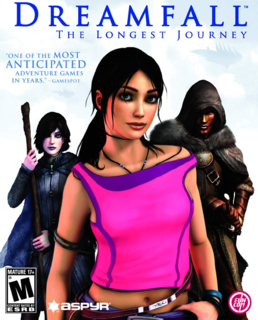An otherwise exceptional game, Dreamfall fails to leave a positive lasting impression due to its gameplay and conclusion
The Longest Journey tells the story of April Ryan, a troubled young woman who suddenly acquires the ability to shift between two parallel universes – between her own world of Stark and Arcadia. Although once a single universe, Arcadia and Stark at some point split into two separate and very different worlds. Arcadia is a quasi-medieval universe of fantasy and magic, while Stark is dominated by science and technology. As the story progresses, it becomes clear that the balance which exists between Arcadia and Stark is in danger as the two worlds inexplicably begin to merge.
Dreamfall takes place ten years after the events in The Longest Journey, namely the restoration of the balance. Ten years have also passed since the Collapse, a mysterious incident that destroyed Stark’s infrastructure and economy, which is also believed to have been caused by the merging of the two worlds. The Collapse fundamentally changed Stark and, unfortunately, not everyone was able to restore their lives after the calamity. April’s hometown of Venice, Newport a once prosperous and vibrant community has become desolate and poverty-stricken.
The new protagonist, however, lives in one of the few cities which have successfully recovered. Zoë Castillo is a young woman who is still unsure of who she is. She is painfully aware of her lack of motivation and she fears that she may never amount to much in life. Her studies in Bioengineering, which perhaps she had chosen in the hopes of following in the footsteps of her father, were cut short as she lost her focus and her interest in the subject and eventually dropped out of the university. Admittedly, your first impression of Zoë may not be entirely positive, but as you gradually discover who she is, Zoë becomes more likable and much more interesting as a character.
Similarly to April Ryan in The Longest Journey, in the beginning Zoë is haunted by mysterious and bizarre visions, which at first seem to be caused by the increasing disruptions in the Wire, which is a global network connecting every electronic device. These disruptions may possibly hint at an impending disaster comparable to the Collapse. However, these visions soon turn into frighteningly vivid dreams as Zoë gradually uncovers the truth behind the disappearance of her journalist friend.
One of Dreamfall’s most notable qualities is the environments which are truly awe-inspiring, with Arcadia deserving special recognition in this respect. From your home in Casablanca to the ancient caverns in Arcadia, the amount of creativity and detail put into the game’s environments is impressive as each place that you visit has a distinctive feel and ambiance. From an entirely technical standpoint, the graphics are pleasant and even on less powerful machines the frame rate is more than acceptable even at higher resolutions with anti-aliasing fully turned on. The character models are detailed and the animations are fluid.
Along the way you will cross paths with a number of memorable characters, some of whom will prove immensely helpful to you while others will try to impede your progress. In this respect, it is important to mention the superb voice acting, which really brings the characters to life and contributes to the game's already gripping story and unique atmosphere. However, one major criticism regarding the narrative is that we do not get a chance to learn more about many of the characters who are essential to the story. Additionally, the political and religious angles of the story are not fully developed and too briskly concluded.
Despite the game’s many impressive qualities, there are a number of things which make Dreamfall a less than stellar title. Perhaps the most disappointing aspect of Dreamfall is the gameplay which consists of going from point A to point B and sitting through cut scenes or participating in lengthy conversations. As a story and character driven game, this approach may be somewhat understandable as it is apparent that the primary concern of the designers was to create an engaging story and an appropriate atmosphere, but the extent to which user interaction takes a back seat ruins the overall experience and diminishes the replay value.
As a story-driven game Dreamfall is understandably very linear. Similar to Atari’s cinematic adventure Indigo Prophecy, in Dreamfall you are sometimes given a choice as to how to respond to a question, which creates the illusion that your actions have an actual effect on the way you progress through the game. However, excluding the few situations where you have two alternative methods of progressing, your responses always lead to the same result. Once you are done with Dreamfall, there isn’t any reason to go back.
The puzzles, which are few and far between, are another disappointment as they are usually simple and very easy to solve. Although most are straightforward, there are several instances where it is simply unclear what the objective is. In similar vein, the combat in Dreamfall is very simplistic and can be considered a chore rather than a source of excitement between puzzles and the lengthy conversations with various NPC’s. Battles are usually quick but a twitchy camera in confined spaces can complicate things. Usually, the key to winning any confrontation is to wait for the opponent to become vulnerable and only then to attack.
In many respects, Dreamfall is a brilliant game which leaves you with a lasting if not an entirely positive impression. It has an intriguing story, many memorable characters and an incredible atmosphere. But due to its simplistic gameplay and an uneven conclusion, Dreamfall fails to provide a satisfying overall experience. More importantly, in the end it fails to make you a part of its universe.

